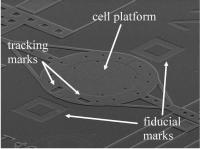
Electron micrograph of the NIST "cell puller," which measures the mechanical properties of a living cell. After the cell spreads and adheres to the center of the 200-micrometer-wide circular platform, half of the platform is pulled slowly away, while a sensor connected to the other half measures the force on the cell. Credit: D. Serrell/NIST Researchers at the National Institute of Standards and Technology (NIST) have developed a microelectromechanical system (MEMS) cell-stretcher that can measure the mechanical properties of a living cell, such as its ability to stick to a surface. The new device is expected to enable novel studies of cell mechanics, which influence basic cell functions such as growth and division, and diseases such as sickle cell anemia and asthma.
The prototype device, described in a new paper,* is believed to be the only technique for studying bulk mechanical properties of a single, whole cell while it is spreading out and sticking to a substrate as it would in the body, says the designer, NIST bioengineer David Serrell. Other biomechanical test methods focus on individual cell components or entire tissues.
The heart of the NIST device is a circular cell platform 200 micrometers wide, a tiny fleck just barely visible to the naked eye. The two halves of the circle can be pulled as far as 100 micrometers apart under computer control, while the force needed to separate them is measured by sensors. In a demonstration using a connective tissue cell, the cell is placed on the center of the platform, allowed to spread and adhere for several hours, and then pulled slowly apart until it detaches. In NIST experiments, the cells let go of the substrate at a force of about 1500 nanonewtons. (One nanonewton is the approximate amount of force required to break a single chemical bond between two atoms.)
The devices are made on silicon wafers using a NIST-developed process based on standard chip-making techniques. The geometry of any component can be altered to suit a variety of cell types and experiments. The apparatus could be used for a variety of studies, such as effects of cyclic strain on cells, the elasticity of their response to force, or the effectiveness of different proteins used to encourage attachment of the cells, Serrell says. The newest version of the device, fabricated but not yet tested, is made of silicon nitride, a transparent material that will allow simultaneous real-time imaging of the interior of the cells and perhaps provide new insights into the relationships of force and cell mechanical properties and structure.
Source : National Institute of Standards and Technology (NIST)
 Print Article
Print Article Mail to a Friend
Mail to a Friend
